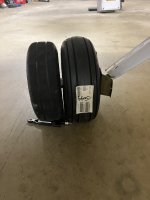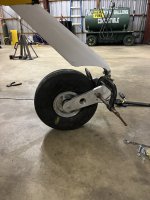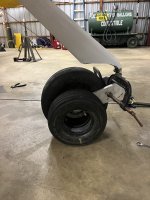Van's Air Force
You are using an out of date browser. It may not display this or other websites correctly.
You should upgrade or use an alternative browser.
You should upgrade or use an alternative browser.
5x5 nose tire on 9A - New wheel required?
- Thread starter edhunter
- Start date
Roy Thoma
Well Known Member
Ed, I've been told by very knowlageable people that a 5:00x5 tire should fit on a wheel that started using a 4:10x5 tire.Considering going with the 380 main tires and a modified front fork on my 9a, with a 5x5 front tire. Is a new front wheel required for the larger tire, or can the stock one be used?
Considering going with the 380 main tires and a modified front fork on my 9a, with a 5x5 front tire. Is a new front wheel required for the larger tire, or can the stock one be used?
Ed,
Are you modifying the fork yourself or a shop is doing it for you?
Planning a shop to do it. But still in the planning stage. BTW, do you know what aluminum Vans uses for the fork? 6061 I'm guessing...Ed,
Are you modifying the fork yourself or a shop is doing it for you?
Could I suggest a thorough review of why nose legs fail is appropriate before fitting a larger wheel?
Assuming you have the original nose leg, it will fail in bending (it will curl up backwards like a snail) when the load imposed by the wheel reaches a certain level. A larger wheel increases the bending loads on the leg, will decrease the load you may put on the nose wheel before the leg fails and will increase the likelihood of failure over the standard set up.
You may decide it is a reasonable way ahead in your case, but please consider all the factors.
A 380x150 tire is only about 1" greater diameter (raises the axle by 1/2") than a 5.00x5 tire.
Assuming you have the original nose leg, it will fail in bending (it will curl up backwards like a snail) when the load imposed by the wheel reaches a certain level. A larger wheel increases the bending loads on the leg, will decrease the load you may put on the nose wheel before the leg fails and will increase the likelihood of failure over the standard set up.
You may decide it is a reasonable way ahead in your case, but please consider all the factors.
A 380x150 tire is only about 1" greater diameter (raises the axle by 1/2") than a 5.00x5 tire.
Yes, these threads have many comments regarding the nose wheel bending. There are also many threads of people making the change. It seems a significant number involve the nose of the front leg contacting the ground and catapulting the rv on its back. So does the bend cause the leg to dig into the ground and flip the plane, or does the leg dig into the ground, bend the leg, and flip the plane?? Seems either could occur. The bend seems to be in the thinner section of the leg proximal to the fork, not at the fork. The 11-4 is a 10.5" diameter, the 5x5 is 13.5". This swap raises the nose 1.5" over stock. Dropping the axle 1.25" gains 2.75" over stock height. It seems this gain plus the wider front tire would lessen the risk of a ground rut, hole, etc grabbing the axle causing as a flip. Yes the bending torque on the nose leg itself does increase. My front weight is 253lbs. If we assume a moment arm of 8.5" ( est normal fork) we get a force of 179 ft/lbs bending load on the leg. Increasing to 9.75" (est) increases the force to 205 ft/lbs. A high G load landing will increase this exponentially.Could I suggest a thorough review of why nose legs fail is appropriate before fitting a larger wheel?
Assuming you have the original nose leg, it will fail in bending (it will curl up backwards like a snail) when the load imposed by the wheel reaches a certain level. A larger wheel increases the bending loads on the leg, will decrease the load you may put on the nose wheel before the leg fails and will increase the likelihood of failure over the standard set up.
You may decide it is a reasonable way ahead in your case, but please consider all the factors.
A 380x150 tire is only about 1" greater diameter (raises the axle by 1/2") than a 5.00x5 tire.
I'm no engineer so please correct my errors if I'm way off base. But it seems an error in landing that will flip a modified front gear leg is very likely to flip a stock gear leg, esp if done on a grass strip. Anyway, I've got a spare front fork so for now this is a trial exercise!
A few pics of where I'm at so far. 380's on the mains, a 5x5 in place on the AS modified nosewheel. C clamps holding the 3/8" modified fork legs against the stock 5/16" fork legs. There is no weight sitting on the nosewheel, no air in the tire in fact.... Crazy how small the stock tire looks next to the 5" one.
Attachments
I visited a place today. Nothing special just a backcountry strip, recently cleaned by volunteer pilots. I would be more comfortable with a bigger wheel, coming with a passenger, camping gear and more fuel...

Well, the tailwheel option is out. I already sold the gear to Ed
Well, the tailwheel option is out. I already sold the gear to Ed
Well, the tailwheel option is out. I already sold the gear to Ed
Maybe a trade in the future!
Finley Atherton
Well Known Member
Consider this before installing a bigger wheel.
During a flip over I believe it is the drag from the bottom of the fibreglass nose cone contacting the ground that starts the strut fold under sequence. In a standard installation there is a gap between the inner surface of the nose cone and the nut/bottom of the strut. I modified my nose cone to eliminate this gap by raising the bottom surface of the nose cone. The bottom of my nose cone to ground clearance has increased to 3.8” which is about the same as a Piper Cherokee. After hundreds of landings on grass and gravel strips I have never even had a scratch on the lower nose cone surface.
Fin 9A
Australia
During a flip over I believe it is the drag from the bottom of the fibreglass nose cone contacting the ground that starts the strut fold under sequence. In a standard installation there is a gap between the inner surface of the nose cone and the nut/bottom of the strut. I modified my nose cone to eliminate this gap by raising the bottom surface of the nose cone. The bottom of my nose cone to ground clearance has increased to 3.8” which is about the same as a Piper Cherokee. After hundreds of landings on grass and gravel strips I have never even had a scratch on the lower nose cone surface.
Fin 9A
Australia
Last edited:
Ed , I have 12 years on a 5 X 5 nose .give me a call and I will share some data. 815 291 8864Maybe a trade in the future!
C'mon Vlad, nothing special but where?I visited a place today. Nothing special just a backcountry strip, recently cleaned by volunteer pilots. I would be more comfortable with a bigger wheel, coming with a passenger, camping gear and more fuel...
View attachment 58708
Well, the tailwheel option is out. I already sold the gear to Ed
C'mon Vlad, nothing special but where?
It's Spiral Jetty Randall you will love it. Place like no others. There is a new windsock on the north side.
The surface is in great shape thanks to Utah backcountry pilots.
Great weather pretty sights. Come.
PaulvS
Well Known Member
Are you able to post a photo of how you did this please? I'm not sure if you just cut the bottom edges higher, or did more extensive fiberglass work?Consider this before installing a bigger wheel.
During a flip over I believe it is the drag from the bottom of the fibreglass nose cone contacting the ground that starts the strut fold under sequence. In a standard installation there is a gap between the inner surface of the nose cone and the nut/bottom of the strut. I modified my nose cone to eliminate this gap by raising the bottom surface of the nose cone. The bottom of my nose cone to ground clearance has increased to 3.8” which is about the same as a Piper Cherokee. After hundreds of landings on grass and gravel strips I have never even had a scratch on the lower nose cone surface.
Fin 9A
Australia
I measured the gap between the floor and the lower edge of the nose wheel cap and it is 2.75". If the wheel pant is off then the gap from floor to gear leg nut is 4.00"
I have a 5x5 nose tire on the 6A I purchased 4 years ago. New forks were welded with spacers. It had the Matco wheel with standard bearings. When my wife was being checked out, from about 400 feet, I could see the nose gear move rapidly fore and aft when the gear touched down. There are changes to the Matco wheel to add a spacer between the bearings but I elected to install the anti splatt bearing mod which appears to eliminate that vibration. I don't know the intention of the original builder but the combination of the larger tire and the standard Matco wheel was not good.
Finley Atherton
Well Known Member
Post from 17 years ago.Are you able to post a photo of how you did this please? I'm not sure if you just cut the bottom edges higher, or did more extensive fiberglass work?
I measured the gap between the floor and the lower edge of the nose wheel cap and it is 2.75". If the wheel pant is off then the gap from floor to gear leg nut is 4.00"
https://vansairforce.net/threads/modified-fairing-for-new-style-nose-fork.20219/
Finley,Consider this before installing a bigger wheel.
During a flip over I believe it is the drag from the bottom of the fibreglass nose cone contacting the ground that starts the strut fold under sequence. In a standard installation there is a gap between the inner surface of the nose cone and the nut/bottom of the strut. I modified my nose cone to eliminate this gap by raising the bottom surface of the nose cone. The bottom of my nose cone to ground clearance has increased to 3.8” which is about the same as a Piper Cherokee. After hundreds of landings on grass and gravel strips I have never even had a scratch on the lower nose cone surface.
Fin 9A
Australia
I don't agree with you. The leg bends and fails then the fairing/fork hits the ground.
A friend analysed the forces involved and the strength of the nose leg, it was clear the leg fails first.
Having said that I flew a 6A for 17 years, landing in all sorts of places (not as adventurous as Vlad) and didn't have a problem.
Landing on the main wheels is key and preventing the nose wheel loading up.
I also strengthened the front of the fairing and didn't get much damage to it, I did have an anti-splat strengthener fitted for half the time.
Pete
So I finished the project. 380s on the mains, 5x5 on the nose. The wheel pants on the mains fit w/o significant modification other than cutting the opening larger, but they're tight on the top. But they do not rub so I'll leave them as is for now. I could see it being an issue if I picked up a rock or something though. I think the plane looks better w/ a slightly nose high attitude (+3º on the longeron) vs the stock nose low setup. I fit the new front tire as close as practical to the nose spindle mount to minimize additional torque on the nose leg.
Weight increased 8lbs overall, not counting the nose pant which was not replaced. Empty nose wheel weight however went down by 12lbs (from 253lbs to 241lbs) , due to the increased height of the nose now. The swap resulted in the airplane now sitting with a 3º nose high attitude. I do have the AS leg brace, the front wheel bearing mod, and the nose lip skid as seen in the photo.
Now if it'd just quit raining I could fly it and see how it feels...
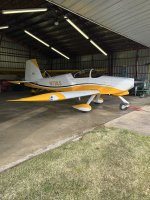
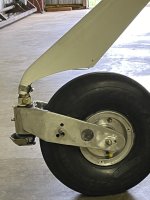
Weight increased 8lbs overall, not counting the nose pant which was not replaced. Empty nose wheel weight however went down by 12lbs (from 253lbs to 241lbs) , due to the increased height of the nose now. The swap resulted in the airplane now sitting with a 3º nose high attitude. I do have the AS leg brace, the front wheel bearing mod, and the nose lip skid as seen in the photo.
Now if it'd just quit raining I could fly it and see how it feels...





